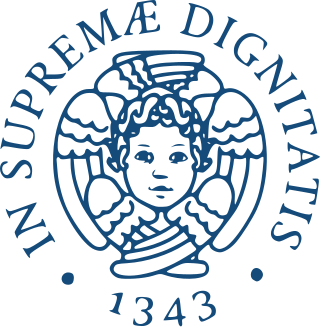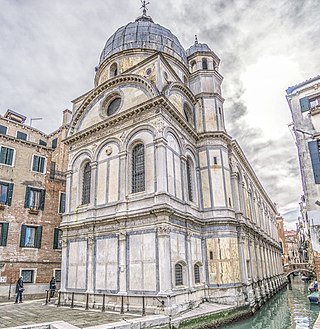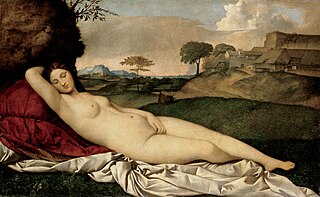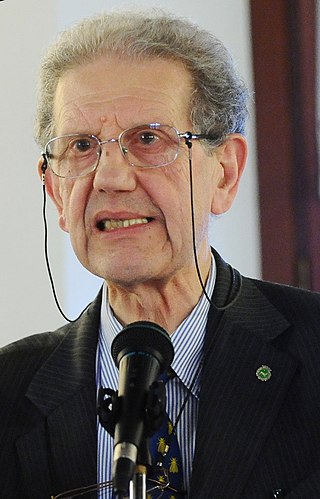Related Research Articles

Vincenzo Scamozzi was an Italian architect and a writer on architecture, active mainly in Vicenza and Republic of Venice area in the second half of the 16th century. He was perhaps the most important figure there between Andrea Palladio, whose unfinished projects he inherited at Palladio's death in 1580, and Baldassarre Longhena, Scamozzi's only pupil.

The University of Pisa is a public research university in Pisa, Italy. Founded in 1343, it is one of the oldest universities in Europe.

Andrea Palladio was an Italian Renaissance architect active in the Venetian Republic. Palladio, influenced by Roman and Greek architecture, primarily Vitruvius, is widely considered to be one of the most influential individuals in the history of architecture. While he designed churches and palaces, he was best known for country houses and villas. His teachings, summarized in the architectural treatise, The Four Books of Architecture, gained him wide recognition.

Villa Emo is one of the many creations conceived by Italian Renaissance architect Andrea Palladio. It is a patrician villa located in the Veneto region of northern Italy, near the village of Fanzolo di Vedelago, in the Province of Treviso. The patron of this villa was Leonardo Emo and remained in the hands of the Emo family until it was sold in 2004. Since 1996, it has been conserved as part of the UNESCO World Heritage Site "City of Vicenza and the Palladian Villas of the Veneto".

The Scuola Normale Superiore in Pisa is a public university institution in Pisa and Florence, Tuscany, Italy, currently attended by about 600 undergraduate and postgraduate (PhD) students.
The Sant'Anna School of Advanced Studies is a special-statute, highly selective public research university located in Pisa, Italy.
Berthold of Moosburg was a German Dominican theologian and neo-Platonist of the 14th century, teaching in Regensburg in 1327.
The Caccioppoli Prize is awarded by the Italian Mathematical Union to an Italian mathematician not exceeding the age of 38 who established a wide international reputation. The prize is entitled to the memory of the Italian mathematician Renato Caccioppoli and is awarded on the occasion of the Italian Mathematical Union conference every four years. In its early stages the prize was awarded every two years. The recipient currently receives 10,000 euros.

Gian Biagio Conte is an Italian classicist and professor of Latin Literature at the Scuola Normale Superiore of Pisa.
Alistair John Rowan is an Irish architectural historian, a retired university teacher, a building conservationist and an author of British, Irish and Italian architectural history.

A Superior Graduate School is a completely independent institution from a legal point of view, which offers advanced training and research through university-type courses or is dedicated to teaching at graduate or post-doctoral level.

Venetian Renaissance architecture began rather later than in Florence, not really before the 1480s, and throughout the period mostly relied on architects imported from elsewhere in Italy. The city was very rich during the period, and prone to fires, so there was a large amount of building going on most of the time, and at least the facades of Venetian buildings were often particularly luxuriantly ornamented.

City of Vicenza and the Palladian Villas of the Veneto is a World Heritage Site in Italy, which protects buildings by the architect Andrea Palladio. UNESCO inscribed the site on the World Heritage List in 1994. At first the site was called "Vicenza, City of Palladio" and only buildings in the immediate area of Vicenza were included.
Sergio Campanato was an Italian mathematician who studied the theory of regularity for elliptic and parabolic partial differential equations.
Mario Salmi was an Italian art historian and art critic who specialized in Romanesque architecture, Tuscan sculpture and the early Italian Renaissance.
Guido Beltramini is an Italian architectural historian and a curator.

The Venetian Renaissance had a distinct character compared to the general Italian Renaissance elsewhere. The Republic of Venice was topographically distinct from the rest of the city-states of Renaissance Italy as a result of their geographic location, which isolated the city politically, economically and culturally, allowing the city the leisure to pursue the pleasures of art. The influence of Venetian art did not cease at the end of the Renaissance period. Its practices persisted through the works of art critics and artists proliferating its prominence around Europe to the 19th century.

Salvatore Settis is an Italian archaeologist and art historian. From 1994 to 1999 he was director of the Getty Center for the History of Art and the Humanities in Los Angeles and from 1999 to 2010 of the Scuola Normale Superiore in Pisa.
David Edward Hemsoll FSA is a British art and architectural historian, specialising in Renaissance art and architecture, especially that of Rome, Florence, and Venice. He has published numerous catalogue essays and books that address architectural theory and the methodology of architectural design. He is currently (2020) Senior Lecturer in the Department of Art History, Curating and Visual Studies at the University of Birmingham.

Luigi Arialdo Radicati di Bròzolo was an Italian theoretical physicist
References
- ↑ Howard Burns. Department of History of Art, University of Cambridge. Retrieved 1 July 2017.
- ↑ Howard Burns, Scuola Normale Superiore, Pisa - emeritus. Palladio Museum. Retrieved 1 July 2017.
- 1 2 Elam, Caroline (2010). "Precision and Fantasia: Howard Burns, scholar and teacher". In Beltramini, Maria; Elam, Caroline (eds.). Some degrees of Happiness: Studi di storia dell'architettura in onore di Howard Burns (PDF). Pisa, Italy: Scuola Normale. pp. xiv–xxii. ISBN 978-88-7642-372-7. OCLC 632165214.
- ↑ Bolgar, Robert Ralph (1964). The Classical Heritage and its Beneficiaries: From the Carolingian Age to the End of the Renaissance. Harper and Row.
- ↑ "Ricerca contenuti". Palladio Museum. Retrieved 12 November 2020.
- ↑ ""Unforced elegance". Una lezione di Howard Burns". Kunsthistorisches Institut in lorenz – Max-Planck-Institut (in German). Retrieved 12 November 2020.
- ↑ "Andrea Palladio, the Revolutionary".
- ↑ "Who made the Conway Library?". Digital Media. 30 June 2020. Retrieved 12 November 2020.